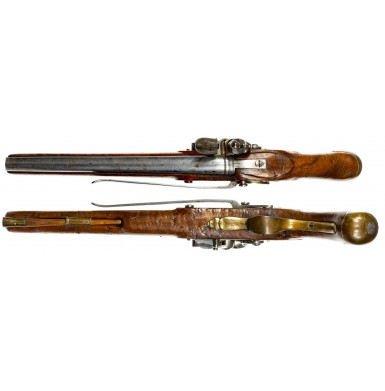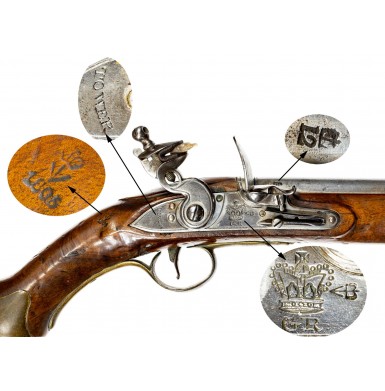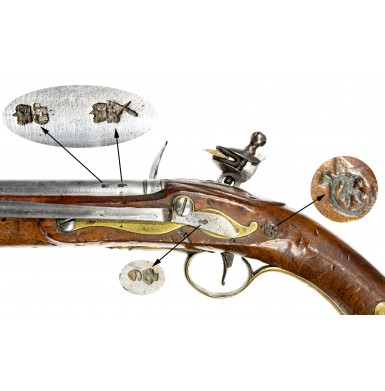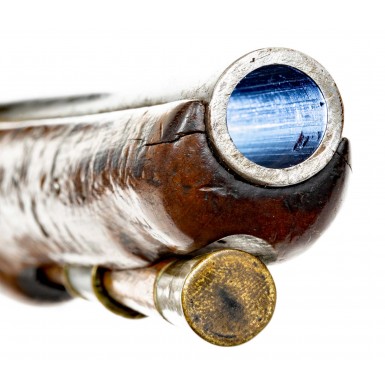British Pattern 1801 Sea Service Pistol Dated 1805
- Product Code: FHG-2213-SOLD
- Availability: Out Of Stock
-
$1.00
The British Royal Navy Sea Service Pistol has the unique distinction of being one of the very few military small arms to retain its basic form for a century of service. While most military arms have service lives of a few decades at most, the flintlock Sea Service Pistol of the British Royal Navy remained in general use from 1716 until 1816, exactly 100 years, with only some minor modifications. While these minor changes, primarily to the locks, have led modern collectors to label the variations as different pattern dates, the reality is that from its introduction circa 1716 through the end of the Napoleonic Wars in 1815, the basic form of the pistol remained unchanged.
The first pattern date applied to the Sea Service pistol in this form is 1716. The Pattern 1716 Sea Service Pistol was very similar to the Land Service Pistol of the same era, in overall appearance and design. The pistol was a single shot, flintlock ignition gun with a 12” long, round iron smoothbore barrel in “pistol bore”, approximately .56 caliber. The guns were of simple, but robust construction, and like their land service brethren were built with an eye towards the gun seeing equal service as a club, as it did as a firearm! In fact, US Naval manuals from the first decades of the 1800s included instruction on how to throw the pistol at an enemy, a tactic that no doubt originated in the Royal Navy. The 12” barrel of the Sea Service pistol was secured to the full-length stock by a pair of transverse wire pins, and a single screw through the breech tang. The forend tip was without cap or reinforcement. The furniture was of brass, with a simple cast brass lobed butt cap that doubled as the head of the pistol butt “club”, a brass triggerguard, a flat brass side plate and a single brass ramrod pipe. A steel belt hook was attached to the reverse of the pistol by the rear most lock mounting screw, and a stud at the inboard rear of the hook engaged a hole in the side plate to keep the belt hook from swiveling when in use. A recurved iron trigger was suspended from a single iron wire pin that passed through the stock and into the lock mortise. A simple, brass-tipped wooden rammer was secured under the stock by the ramrod pipe.
The lock was the one area that showed the largest amount of variation, and the pattern of lock is the principle reason for the various pattern date designations assigned to these pistols. The earliest Pattern 1716 pistols used the Pattern 1716 Sea Service Lock, which was flat with a semi-banana shaped profile with an integral, faceted, unbridled iron pan without a fence, and a flat reinforced cock (hammer). The plates were pointed to the rear and did not have the boarder-line enhancements of later pistol locks. All of the lock markings were engraved. These included the lock contractor’s name, as well as the lock’s date at the tail of the lock, and the royal crown over “GR” royal cypher forward of the hammer. The Pattern 1716/77 Sea Service Pistol was in in essence identical to the Pattern 1716, with the exception of the adoption of the new Pattern 1777 Sea Service pistol lock. The new lock featured a shorter sear spring, which meant that the ends of two internal screws are visible to the rear of the hammer, while the older 1716 lock had the end of the sear spring screw concealed behind the hammer. The Pattern 1777 lock also introduced a rounded pan with a bridle.
The final variation of the pistol was again for all reasonable purposes identical to the two previous variations, with the exception of the lock, which was the new India Service pistol lock. It was adopted for use with the Sea Service pistol in 1801 and that is the designation that this final variation carries, the Pattern 1801. The refinements of the new lock were primarily simplifications and production improvements. Visually the most identifiable features were the addition of a fence to the rear of the round iron pan and the change from engraving the markings on the lock to stamping them. With the simplification of the marking system, aesthetic enhancements like stamped boarder lines around the lock and body of the cock were added. The pistol remained unchanged in this variation until 1816, when it was determined that the barrels of the pistols should be shortened from 12” to 9”, and many Pattern 1801 pistols were subsequently shortened.
Other than some changes in the lock system, the long barreled Royal Navy Sea Service Pistol remained in the same basic form from and in constant service from 1716 to 1816, a claim that very few other military arms can make. These pistols saw service during the entire range of British Wars during that century of service, from The War of the Quadruple Alliance (1717-1720) to the War of the Austrian Succession (1740-1748), to the Seven Years’ War (or French & Indian War 1756-1763), through the American Revolution (1775-1783), and into the era of the Napoleonic Wars (on and off from 1793-1815, through 7 coalitions), and the War of 1812 (1812-1815), just to list the major wars that occurred during their service. It was the British Royal Navy that time controlled the seas during that time and extended British power around the globe. These pistols were a small part of the Royal Navy’s ability to project British influence beyond the horizon of the British Isles.
This particular British Pattern 1801 Sea Service Pistol is in about VERY FINE condition. The pistol is well marked throughout with the lock bearing the usual {CROWN} / GR cypher of King George III (King of England 1760-1820) forward of the hammer, the word TOWER in a vertical arc to the rear of the hammer. A British military {CROWN} – {BROAD ARROW} ownership mark is present under the pan. The style of the royal cypher mark is typical of the marks found on British military locks c1805. The lock is a Pattern 1801 “India Pattern” pistol lock, which was a simplified version of the earlier P1777 pistol lock. The flat P1801 lock has stamped markings rather than engraved markings and added a fence to the pan. The lock derived its name from the East India Company pattern guns that the lock was copied from. The simplifications in production were wartime expedients to increase the rate of production for small arms, as Great Britain was heavily engaged in war with Napoleon at that time. The interior of the lock marked with the inspection stamp {CROWN} / 36 and with the number 8 at the interior tail. As all of the arms were assembled from handmade, non-interchangeable parts, a mating system of file slashes was adopted and used through the assembly process. It is not uncommon to find more than one set of assembly marks on British small arms from the 18th century and first part of the 19th century, as various parts and components were fit together during the assembly process. In this case, the lower edge of the lock is marked XIII forward of the hammer. This mark also appears in the ramrod channel of the stock and likely under the barrel, which was not removed due to the need to drive out the pins. The left breech of the barrel is marked with typical British military proofs from the era, a {CROWN} / GR / {BROAD ARROW} and a {CROWN} / {CROSSED SCEPTERS}. The style of the markings dates them to the period of about 1790-1810. The right side of the breech, above and forward of the touchhole, is marked with a {CROWN} /12 inspection. This is a common inspection mark for Sea Service pistol touchholes of the era, and I have noted that inspectors “11” and “12” are often encountered in this location on Sea Service pistols. The rear of the barrel tang is stamped with a {CROWN}. The rear of the belt hook is stamped with a {CROWN} / 6, another common inspection mark for that piece. The ramrod channel is marked with the assembly mating mark mentioned above and bears several Crown over number acceptance and inspection stamps, which are only partially legible due to wear in the channel from inserting and removing the ramrod. A {CROWN} / {BROAD ARROW} / 1805 storekeeper’s mark is stamped just above the raised carving extension in the stock behind the lock. The mark is deeply and clearly stamped, although the crown is a little weak due to being stamped on a rounded surface. For whatever reason, the 1805 storekeeper’s date is probably the most often encountered one, suggesting they may have continued to use that stamp even after 1805. The large majority of the markings, even those in the wood, remain crisp and clear; with only a couple showing enough wear to have become less legible. The lock is in EXCELLENT mechanical condition and functions crisply and correctly on all positions. The lock is in its original flintlock configuration and is not a reconversion to flint. The frizzen spring retains great strength and would no doubt spark smartly against the steel with the flint that is in the jaws. The touchhole is well centered in the pan and remains very crisp and sharp with no notable erosion or wear. The lock has been very lightly cleaned and has been lightly buffed to bright. Some traces of old dried oil and some light surface oxidation have left a splotchy brownish patina in the recesses of the lock, on the hammer and over much of the barrel as well. The metal of the lock and hammer remain quite smooth, with only a few tiny areas of light pinpricking present, and couple of minor dings on the flat of the hammer body and edge of the frizzen spring. The barrel of the pistol has been similarly cleaned, but only in an attempt to remove old dirt, grime and dried oil. The 12” round barrel is full length and retains a pair of well-defined baluster-turned rings at the breech and relatively clear proof marks. The metal is mostly smooth, with only a few patches of very lightly scattered pinpricking and discolored oxidized freckling present on the barrel, mostly around the breech and muzzle areas. The bore of the pistol remains quite smooth and is in FINE condition. The bore remains mostly bright with only some lightly scattered pinpricking along its length and a few small areas of minor pitting present in a couple of darker patches. The pistol retains its original belt hook, with mating marks that match the balance of the pistol. This is unusual and real bonus as Sea Service pistol belt hooks are usually missing or are reproduction replacements. The brass furniture is in fine condition throughout and had a dark ocher patina that is very attractive. A brass tipped wooden rammer is in place in the channel under the stock and is full-length. The rammer configuration is correct, and the quality is excellent. This suggests that it could be an original ramrod. It shows some age and matches the pistol well, particularly the patina of the brass. If it is not original it is truly a very high quality replacement and of museum quality. The stock of the pistol rates about FINE as well and remains very crisp. Although the stock shows numerous bumps, dings and minor mars from service and storage over the years, the stock remains very sharp. The raised carved apron (called a “beaver tail” by most American collectors) that surrounds the breech plug tang remains very crisp and the accompanying apron with oval final to rear of the lock is equally well defined. The stock shows no signs of having been sanded, and all marks remain crisp and sharp except those blurred by contact and wear from use. The stock is complete, solid and full length with no breaks or repairs noted. A couple of very small grain cracks are present at the tip of the stock, near the muzzle. The one on the right is less than 1” long and an even tighter, shorter one is present on the left side. These are not uncommon because of the lack of forend cap or forend reinforcement.
Overall this is really a FINE example of an original flintlock British Sea Service pistol from the middle of the Napoleonic War period. This pistol no doubt saw service during a very turbulent time within the British Empire, with the both the Napoleonic Wars and the War of 1812 all taking place during its service life. Whether the pistol ever saw service in American waters is hard to know, but it likely fired shots in anger from a ship such as the fictional HMS Surprise in the hands of a British sailor like Captain “Lucky” Jack Aubrey (the Russell Crowe character in Master & Commander). British Sea Service flintlock pistols like this are hard to find in such crisp and complete condition, especially when you realize that the pistol is 214 years old! This would be a wonderful addition to any early 19th century martial arms collection, especially one that concentrated on naval arms, British arms, the War of 1812 or the Napoleonic Wars.
SOLD
Tags: British, Pattern, 1801, Sea, Service, Pistol, Dated, 1805











